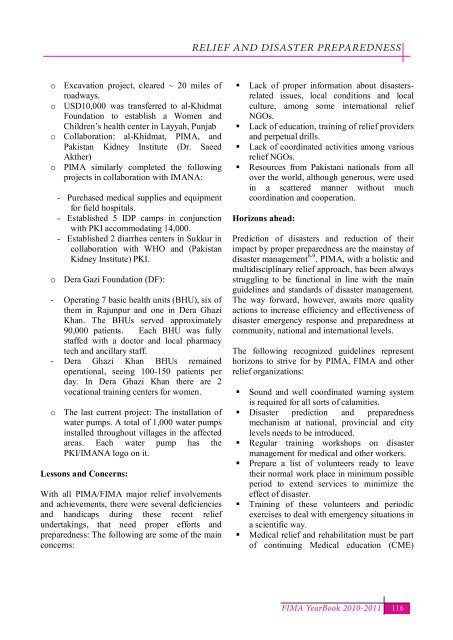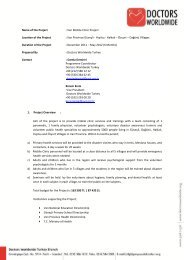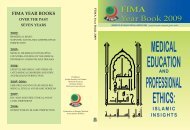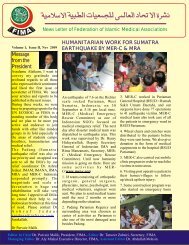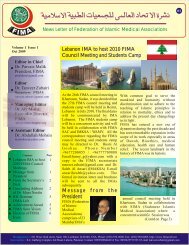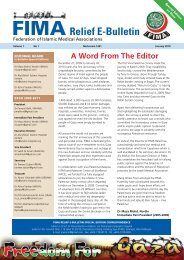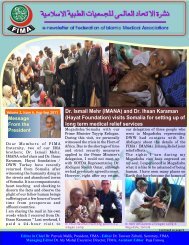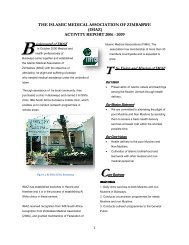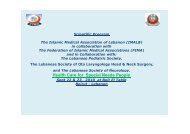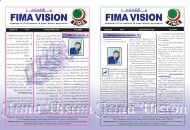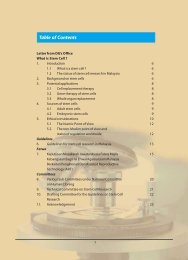FIMA Year Book 2010-2011 - Federation of Islamic Medical ...
FIMA Year Book 2010-2011 - Federation of Islamic Medical ...
FIMA Year Book 2010-2011 - Federation of Islamic Medical ...
Create successful ePaper yourself
Turn your PDF publications into a flip-book with our unique Google optimized e-Paper software.
RELIEF AND DISASTER PREPAREDNESS<br />
o Excavation project, cleared ~ 20 miles <strong>of</strong><br />
roadways.<br />
o USD10,000 was transferred to al-Khidmat<br />
Foundation to establish a Women and<br />
Children’s health center in Layyah, Punjab<br />
o Collaboration: al-Khidmat, PIMA, and<br />
Pakistan Kidney Institute (Dr. Saeed<br />
Akther)<br />
o PIMA similarly completed the following<br />
projects in collaboration with IMANA:<br />
- Purchased medical supplies and equipment<br />
for field hospitals.<br />
- Established 5 IDP camps in conjunction<br />
with PKI accommodating 14,000.<br />
- Established 2 diarrhea centers in Sukkur in<br />
collaboration with WHO and (Pakistan<br />
Kidney Institute) PKI.<br />
o Dera Gazi Foundation (DF):<br />
- Operating 7 basic health units (BHU), six <strong>of</strong><br />
them in Rajunpur and one in Dera Ghazi<br />
Khan. The BHUs served approximately<br />
90,000 patients. Each BHU was fully<br />
staffed with a doctor and local pharmacy<br />
tech and ancillary staff.<br />
- Dera Ghazi Khan BHUs remained<br />
operational, seeing 100-150 patients per<br />
day. In Dera Ghazi Khan there are 2<br />
vocational training centers for women.<br />
o The last current project: The installation <strong>of</strong><br />
water pumps. A total <strong>of</strong> 1,000 water pumps<br />
installed throughout villages in the affected<br />
areas. Each water pump has the<br />
PKI/IMANA logo on it.<br />
Lessons and Concerns:<br />
With all PIMA/<strong>FIMA</strong> major relief involvements<br />
and achievements, there were several deficiencies<br />
and handicaps during these recent relief<br />
undertakings, that need proper efforts and<br />
preparedness: The following are some <strong>of</strong> the main<br />
concerns:<br />
• Lack <strong>of</strong> proper information about disastersrelated<br />
issues, local conditions and local<br />
culture, among some international relief<br />
NGOs.<br />
• Lack <strong>of</strong> education, training <strong>of</strong> relief providers<br />
and perpetual drills.<br />
• Lack <strong>of</strong> coordinated activities among various<br />
relief NGOs.<br />
• Resources from Pakistani nationals from all<br />
over the world, although generous, were used<br />
in a scattered manner without much<br />
coordination and cooperation.<br />
Horizons ahead:<br />
Prediction <strong>of</strong> disasters and reduction <strong>of</strong> their<br />
impact by proper preparedness are the mainstay <strong>of</strong><br />
disaster management 6-9 . PIMA, with a holistic and<br />
multidisciplinary relief approach, has been always<br />
struggling to be functional in line with the main<br />
guidelines and standards <strong>of</strong> disaster management.<br />
The way forward, however, awaits more quality<br />
actions to increase efficiency and effectiveness <strong>of</strong><br />
disaster emergency response and preparedness at<br />
community, national and international levels.<br />
The following recognized guidelines represent<br />
horizons to strive for by PIMA, <strong>FIMA</strong> and other<br />
relief organizations:<br />
• Sound and well coordinated warning system<br />
is required for all sorts <strong>of</strong> calamities.<br />
• Disaster prediction and preparedness<br />
mechanism at national, provincial and city<br />
levels needs to be introduced.<br />
• Regular training workshops on disaster<br />
management for medical and other workers.<br />
• Prepare a list <strong>of</strong> volunteers ready to leave<br />
their normal work place in minimum possible<br />
period to extend services to minimize the<br />
effect <strong>of</strong> disaster.<br />
• Training <strong>of</strong> these volunteers and periodic<br />
exercises to deal with emergency situations in<br />
a scientific way.<br />
• <strong>Medical</strong> relief and rehabilitation must be part<br />
<strong>of</strong> continuing <strong>Medical</strong> education (CME)<br />
<strong>FIMA</strong> <strong>Year</strong><strong>Book</strong> <strong>2010</strong>-<strong>2011</strong> 116


